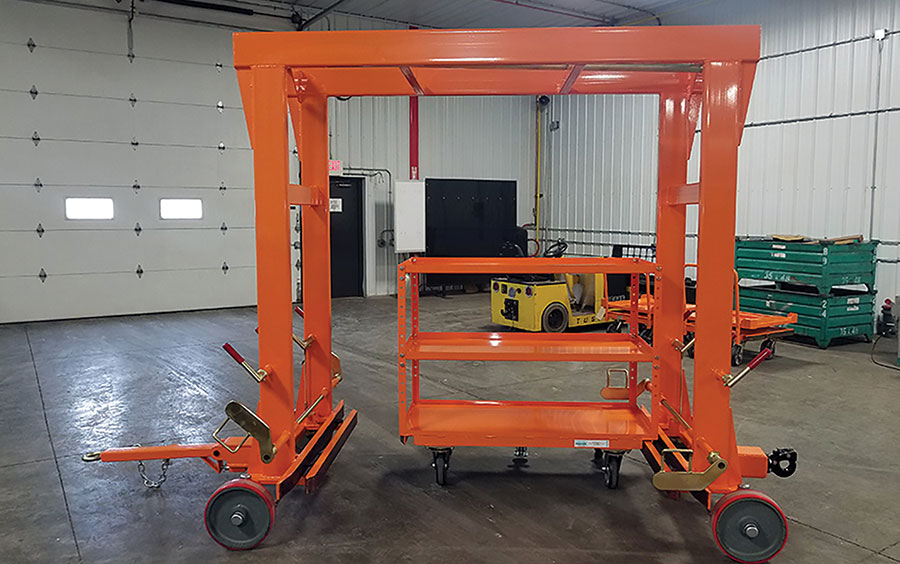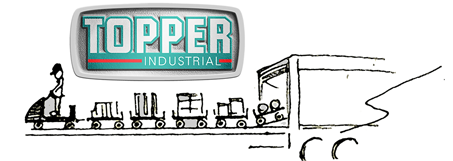Read digital issue NOW!

Carts, tuggers and casters: The unsung heroes of the warehouse
Here’s how manufacturers of carts, tuggers and casters are helping companies navigate the complexities of a labor shortage, a global pandemic and the ongoing e-commerce boom.
By Bridget McCrea, Editor · September 11, 2020
Survey the modern warehouse or DC and you just might overlook the carts, tuggers and casters that literally keep the wheels turning in these expansive facilities. Sure, they may not always be the focal point in the push to automate, digitize and modernize these operations, but all three pieces of equipment continue to play a vital role in warehouse and DC operations worldwide.
The global pandemic expanded that role as facilities scrambled to accommodate new social distancing rules, implement “touchless” processes and protect workers from the outbreak. Through it all, most companies were also working with fewer human resources.
“A lot of companies are shorthanded right now and trying to do more with less,” says Creform’s vice president of sales Keith Soderlund. “As a result, our automatic guided vehicle (AGV) business has been pretty strong this year.”
Companies that were already adding AGVs and other automated tools to their warehouses and DCs ramped up those efforts when Covid-19 emerged. “It was coming anyway, but Covid reinforced it a bit,” Soderlund says. “It’s certainly one way to keep workers apart.”
Over the last year, Creform has developed several new AGVs (some of which are tuggers). The company also provides carts for customers who need them. Creform’s newest models include enhanced functionalities like more integrations to other equipment and Internet of Things ( IoT) connections to upper-level production systems.

Carts can help companies handle labor challenges.
“For a long time, AGVs operated as separate systems; they weren’t connected to anything else,” Soderlund explains. “That’s changing thanks to improved wireless communications.” Looking ahead, he says the company is exploring more “free navigation” AGVs, which currently navigate using magnetic tape strips. “The future is going to more mobile robot-type concepts.”
If they can dream it, we can make it
There was a time when customers picked their casters out of a catalog and understood that their choices were limited to what was on the page in front of them.
Fast-forward to 2020 and the same company has a much broader array of choices when it comes to the sophisticated mechanisms that allow carts, tuggers and other pieces of equipment to move about the warehouse.
“Pretty much whatever someone can imagine, we can build for them,” says Mark Lippert, vice president of marketing at Hamilton Caster, which recently began making wheels that have poly brushes attached to them. “Years ago, there were five or six common wheel choices. Today, there’s a lot more diversification and a much broader offering of both casters and wheels.”
That product diversification is going to continue. For example, Lippert says companies will be able to choose not only their wheels and casters, but also select which toe guards, brakes, ergonomic features, and safety add-ons that they want. “The market is in a place right now where companies can get whatever they want,” he explains, “at a reasonable cost.”
The aging American workforce, the need to reduce worker fatigue, and a desire to reduce workers’ compensation claims are all helping drive this trend. Safety managers are getting more involved with caster buying decisions, says Lippert, and recognizing that a cart that’s easier to push equates to fewer injuries in the long run.

When upgrading your carts, look for a supplier that can help you recycle or reuse the equipment that’s already in place.
Ergonomic wheels and casters, for instance, require minimal force to get moving and stay in motion. They also help reduce noise levels in the facility. “Casters can make a lot of noise as they’re being towed,” says Lippert. “Knowing this, more customers are asking for ‘quieter’ casters for their facilities.”
In response, Hamilton Caster developed a new line of ergonomic wheels and casters, and also publishes the “start and maintain” forces for each of its products on its website. “Safety managers and ergonomists are looking for that type of data,” says Lippert. “We’re testing our products from their lower capacities and all the way to the maximum load of those particular wheels.”
Managing labor constraints
In 2019, Ed Brown had a single customer interested in a Topper Industrial automatic transfer cart. This year, he’s already sold two of these carts and has at least 10 more customers interested. The uptick in demand could be due to Covid-related workplace shifts, and the need for more automation both to handle repetitive tasks and keep workers 6 feet from one another.
Pulled by an AGV, the cart is equipped with a power motor and computer. Working hand-in-hand with the AGV, the cart picks up and drops off pallets, containers or other items. “We’ve been building these carts for three or four years, but all of a sudden they’ve taken on a life of their own,” says Brown, who is the company’s president. Demand is so high for the automatic transfer carts that he expects them to represent 25% of Topper’s business in 2020. “That’s a big number for us.”
Brown says the sudden interest in its automatic transfer carts caught Topper off guard, although he thinks he knows why it happened. “It could be that companies are looking to offset their labor challenges. Even here, one of our biggest headaches right now is finding employees,” says Brown, who adds that he recently heard from one 900-person manufacturing plant where 25% of the workforce was absent on any given day. “It’s a tough time for a lot of companies.”
From Topper, customers in the automotive and agricultural sectors are also asking for carts that can be safely elevated 40 to 50 feet in the air (using a forklift) and used for order picking and putaway. “We started making these for the automotive industry, then the agricultural sector got very interested in them as well,” says Brown. One large agricultural equipment manufacturer, for example, is implementing the carts across six different plants.
Diving in headfirst
Kevin Kuhn, president at Kinetic Technologies, is also seeing more demand for automated carts and tuggers right now. “With all of the uncertainty around labor and health right now,” he points out, “companies are looking for automated solutions across every aspect of materials handling.”
Those companies are also dealing with higher demand for e-commerce orders (due to more people shopping from home), the need to close last-mile delivery gaps, and supply chain disruptions. Add labor challenges to the mix, and it’s clear why Covid-19 accelerated an automation trend that was already underway prior to the pandemic.
“We were already moving toward more automation in the warehouse,” says Kuhn, “but I think we’re going to skip a phase of it as companies continue to just ‘dive in’ as the opportunity arises.”
For carts, tuggers and casters makers, automation mostly involves the use of AGVs to help reduce reliance on labor; designing touchless devices (like conveyor systems) that move product through the facility; and interfacing with other, automated devices to create a holistic fulfillment platform. “With more connected systems being put into DCs,” says Kuhn, “we’re making products that comprise one aspect of those larger systems.”
Come up with a plan of action
To companies that are investing in carts, tuggers and casters this year, Kuhn says the best approach is to check out everything that’s available on the market and talk to people who are already using that equipment in settings that are similar to yours.
“Do your homework,” says Kuhn. “Look for a vendor that has experience in the market versus working with a company that doesn’t really have their full arsenal geared up and ready to go.”
Once you’ve identified a vendor (or vendors) to work with, create a plan of action for your entire facility versus attacking it piecemeal. The latter may be tempting during these uncertain economic times, where belt-tightening has become an imperative for many organizations, but Kuhn cautions against it.
“Coming up with a large-scale, overarching plan first will help you in the long-term,” Kuhn says. “We’re all desperate to reduce labor and operational costs, but it’s better to think it through and execute your complete long-term and short-term plans, rather than just saying, ‘I have to fix this now, and that’s all I’m worried about.’”
Soderlund says to look for a supplier that can help you recycle or reuse the equipment that’s already in place. This means less to dispose of, less materials needed to build the new equipment, and better environmental sustainability. For example, he says Creform helps its customers recycle the piping joint components that they already have on site.
“In some cases, companies have a surplus of those items and/or structures that they don’t need anymore,” he points out. “We help design new carts that meet today’s needs while also providing a degree of ‘built-in recyclability.”
Find Original Article Online HERE.
About Topper Industrial
For more than twenty years, Topper Industrial (www.topperindustrial.com) has been and continues to be a leading manufacturer of material handling equipment. Topper provides lean material handling solutions to the supply chain.
Topper Industrial is able to engineer and design Industrial Carts (Mother / Daughter Cart Systems, Quad Steer Carts or Tracking Carts, Specialized Delivery Carts, Transfer Carts with Roller Deck, Static Carts, Rotation Carts, Tilt Carts or Kitting Carts), Industrial CartComponents (Parts Department), Industrial Containers(Corrugated Containers), Pallets, Lift/Tilt Systems, and Racking. Topper Industrial designs all products with ergonomics in mind, focusing on ease of use and best positioning of material to get the job done. Topper Industrial is a proud member of MHI. Follow on Twitter @TopperInd. Call 800-529-0909. Contact pr@topperindustrial.com.

